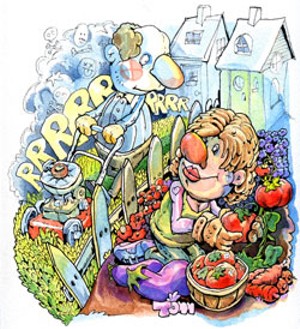Published May 12, 2010 at 4:59 a.m.
While most people spend heaps of money and time to get their lawn looking like a plush green carpet, Michaela Maestas wants nothing to do with the hassle. The self-described “radical environmentalist” has spent the last four years gardening nonstop to rid her lawn of, well, lawn.
“The thought of having a lawn drives me crazy,” Maestas says, looking out over the dozen verdant garden beds that fill her front yard.
While Maestas may consider her assault on grass radical, the idea of converting lawns to gardens is taking hold in the mainstream. As homeowners recognize the true costs of maintaining a pristine lawn — the resources expended in mowing, fertilizing, watering and weed management — the idea of an expanse of green begins to lose its sheen. Plus, the recession has combined with the localvore movement to make backyard agriculture seem attractive.
No hard figures are available on the number of people in this region who have torn out some or all of their lawns and replaced them with gardens. But Dan Goossen, general manager of Intervale Compost Products, says interest is growing. Goossen has seen a sizable uptick in the number of locals buying compost with which to start new gardens.
When the economic downturn reached its nadir, garden centers began seeing more novice gardeners looking to grow their own food, says Jim Flint, executive director of the Friends of Burlington Gardens. A well-maintained vegetable garden can yield an estimated half-pound of fresh produce per square foot of garden per growing season.
That initial surge has led to “steady sustained interest” in home gardens, though Flint says it’s too soon to tell how sustainable the trend will be in our region. Front- and backyard gardening are not without their challenges, from sandy soil to hungry squirrels.
But one good reason to push for lawn-to-garden conversions is that lawns are resource hogs, Goossen says. The average American lawn sucks up about 8000 gallons of water a year, whereas a one-acre organic plot uses just 3000 gallons. According to the Environmental Protection Agency, a lawn mower can emit as much carbon in one hour as a car does in a 200-mile ride.
To encourage seasoned gardeners and inexperienced black thumbs alike to consider replacing their grass with tomatoes, peas and lettuce, Intervale Compost Products launched the Turn My Lawn Into a Garden Contest in early spring. Of the more than 100 entries it received, one made an especially compelling, poignant case for conversion.
Meg Wallace, who lives in Burlington’s Old North End, has been gardening for as long as she can remember. Five years ago, after being functionally homeless, Wallace bought a split-level duplex with the help of the city’s Community and Economic Development Office.
With starter plants she received from her mother and friends, Wallace established vibrant gardens of evening primrose and morning glory, iris and phlox. Over the years, her foliage crept from her property to the greenbelt down the road.
In her earnest and persuasive essay, Wallace, who is disabled, describes how her flower gardens created pride in her neighborhood. But, she writes, while the flowers are lovely and convey a sense of calm and neighborliness, she has pined for a vegetable garden. Like many properties in the Old North End, her Washington Street yard is at high risk for lead contamination, and she doesn’t think it is safe to grow food there.
“Unfortunately, and as many, I live on a very tight budget, and while I have — with the help of many community donations — been able to expand greenbelt plantings every year, I haven’t been able to afford to install safe raised beds for food gardens,” Wallace writes, “although both I and my tenants have dearly wanted these.”
On a drizzly Thursday, nearly two months after Wallace submitted her essay, volunteers from Intervale Compost Products, Burlington Permaculture and Grow Team ONE came together in Wallace’s cozy, lilac-scented backyard to make her food garden a reality by installing raised beds. Local permaculture guru Mark Krawczyk plunged a broadfork into the ground to loosen the soil, as Eric Van Vlandren of Intervale Compost sawed hemlock planks to make the beds.
Other volunteers dug a hole in a bed full of daylilies, daffodils and forget-me-nots; it was the future site of a new peach tree. By the end of the day, Wallace had two raised beds in which she and her tenants could grow a bounty of produce.
Wallace had the will to grow food; she just needed the means. For other homeowners, it may be the other way around. While Intervale Compost’s Goossen says only good things can happen when lawns are torn out and replaced with gardens, he acknowledges that many people approach that process with apprehension. The average American lawn may require 8000 gallons of water a year to keep it looking nice, but “you know what to do,” Goossen points out. Lawns are predictable in a way that vegetable gardens can never be. Plus, they don’t require a lot of brainpower.
“A garden requires some thinking,” Goossen says. “You have to pay attention to your soil. And you have to be more aware of what’s going on with the weather.”
Where should a beginner who wants to make the transition start? Every garden expert in the area will tell you that, before you even think about planting food crops in your urban yard, you need to have your soil tested. (See sidebar.) If contaminants are found, raised beds like Wallace’s are the way to go.
When New North Ender Maestas moved into her home on Woodbury Road, crushed beer bottles, plastic wrappers and garbage bags littered her backyard. It’s taken her years of building up the soil to make it rich and productive.
In four different gardens that take up the bulk of her property, Maestas grows varieties of tomatoes, peppers, eggplant and asparagus that she plucks right out of the ground and eats raw. Her berries have done well, and she’s experimenting with grapes. Despite last year’s tough growing season, Maestas has big hopes for her hops, too.
The only grass that remains in Maestas’ yard is a web of green that serves as a garden path. She has visions of planting three more beds and replacing a Norway maple in her yard with two dwarf cherry trees. Her goal is to be as self-sufficient as she can be in her patch of suburbia.
Mara Welton, who also lives in the New North End, has similar feelings. Shortly after she and her husband, Spencer, moved into their Tracy Drive home, they set about tilling most of the front lawn. “Mowing just seemed silly,” Welton says.
Of course, the conversion from lawn to garden was a little easier for the Weltons. As proprietors of Half Pint Farm in Burlington’s Intervale, the couple are no strangers to gardening. With farm tools and leftover starts, they were able to create a miniature farm at home.
That home garden isn’t just a smaller version of their Intervale enterprise. Welton says the front yard gives the pair an opportunity to grow some unconventional vegetables, including Dill’s Atlantic giant pumpkins and Dutch flat-head cabbage, as well as things they wouldn’t grow for their business, such as dry beans and edible flowers. The Weltons have also planted rosemary, oregano, lavender and other perennial herbs in their backyard, and they are waiting for a number of pear, apple and cherry trees to fruit.
Tending a large home vegetable garden in addition to a two-acre farm sounds like a big effort. But the Weltons don’t see this as bringing their work home with them — they’re just doing what they like to do. They chose an agricultural lifestyle, Welton says. Plus, she jokes, “when you’re a farmer, you don’t want to go to the grocery store for cilantro.”
Lawn-to-garden advocates argue that manicured expanses of earth occupied by just one type of vegetation — what they call monoculture — just aren’t natural. But you don’t have to be a “radical environmentalist” — or any kind of theorist — to appreciate that backyards full of herbs, lettuce and root vegetables are nature at its finest.
Foiling Soil Problems
Urban soil is very different from that of other areas. Repeated disturbances have generally robbed it of structure and fertility. It can also contain lead, arsenic, asbestos and other nasty contaminants that you don’t want entering your body. In other words, it’s not good dirt.
So, if you’re thinking of starting a garden in urban soil, it’s best to get the dirt tested first. Soil testing can show which minerals or nutrients your soil lacks or contains in excess, and it can reveal a variety of other issues, including lead contamination. For a test kit ranging in price from $10 to $15, you can determine whether your soil is safe for growing food. No one wants to eat a juicy tomato full of lead.
When to test:
Test your soil in the spring or fall when it’s more stable. Make sure the soil temperature is above 50 degrees Fahrenheit and fairly dry.
What you will need:
A shovel
A bucket
Clean paper or fabric
A sample kit, available from the University of Vermont Extension offices and select garden stores
How to test:
1. Dig a hole. The depth will depend on what you plan to plant. Twelve inches for a tree; 8 inches for vegetables.
2. Using your shovel, take a thin slice down the side of the hole for your sample. Repeat steps two and three until you have eight samples from various areas of the garden.
3. Remove all roots, mulch and plant debris from the samples.
4. Combine the samples in a bucket and mix.
5. Spread the soil mixture over clean paper or fabric to air dry for a day or so.
6. Gather half a cup to one cup of the soil and place it in a sealed plastic bag.
7. On a label, write your name, address, a description of the sample (e.g., flower garden or turf grass) and the information you’re requesting.
8. When using the mailer, place the bag holding the soil sample inside the cloth bag and tie the drawstring tightly.
9. Include any other paperwork provided by the lab.
10. Mail the sample and, in a few weeks, you should have the results. If they’re good, then get gardening!
Source: Burlington Permaculture, www.burlingtonpermaculture.org
More By This Author
About the Artist

Michael Tonn
Bio:
Michael Tonn is still just eating gummy bears outside the Shopping Bag in Burlington. To see more of his work and to get in touch, go to michaeltonn.com or @dead_moons on Instagram.
Michael Tonn is still just eating gummy bears outside the Shopping Bag in Burlington. To see more of his work and to get in touch, go to michaeltonn.com or @dead_moons on Instagram.
Speaking of...
-

Q&A: Howard Fisher Delivers Meals on Wheels With a Side of Good Cheer
Dec 20, 2023 -

Video: Howard Fisher Delivers Meals on Wheels
Dec 14, 2023 -

Q&A: Alexis Dexter Rescued 57 Shelter Cats During the July Flood
Sep 13, 2023 -

Video: Two Months After the Flood, Alexis Dexter Rebuilds Kitty Korner Café in Barre and Continues to Rescue Cats
Sep 7, 2023 -

Did Your Garden Flood? Here's What to Know
Jul 28, 2023 - More »
Comments
Comments are closed.
From 2014-2020, Seven Days allowed readers to comment on all stories posted on our website. While we've appreciated the suggestions and insights, right now Seven Days is prioritizing our core mission — producing high-quality, responsible local journalism — over moderating online debates between readers.
To criticize, correct or praise our reporting, please send us a letter to the editor or send us a tip. We’ll check it out and report the results.
Online comments may return when we have better tech tools for managing them. Thanks for reading.














































